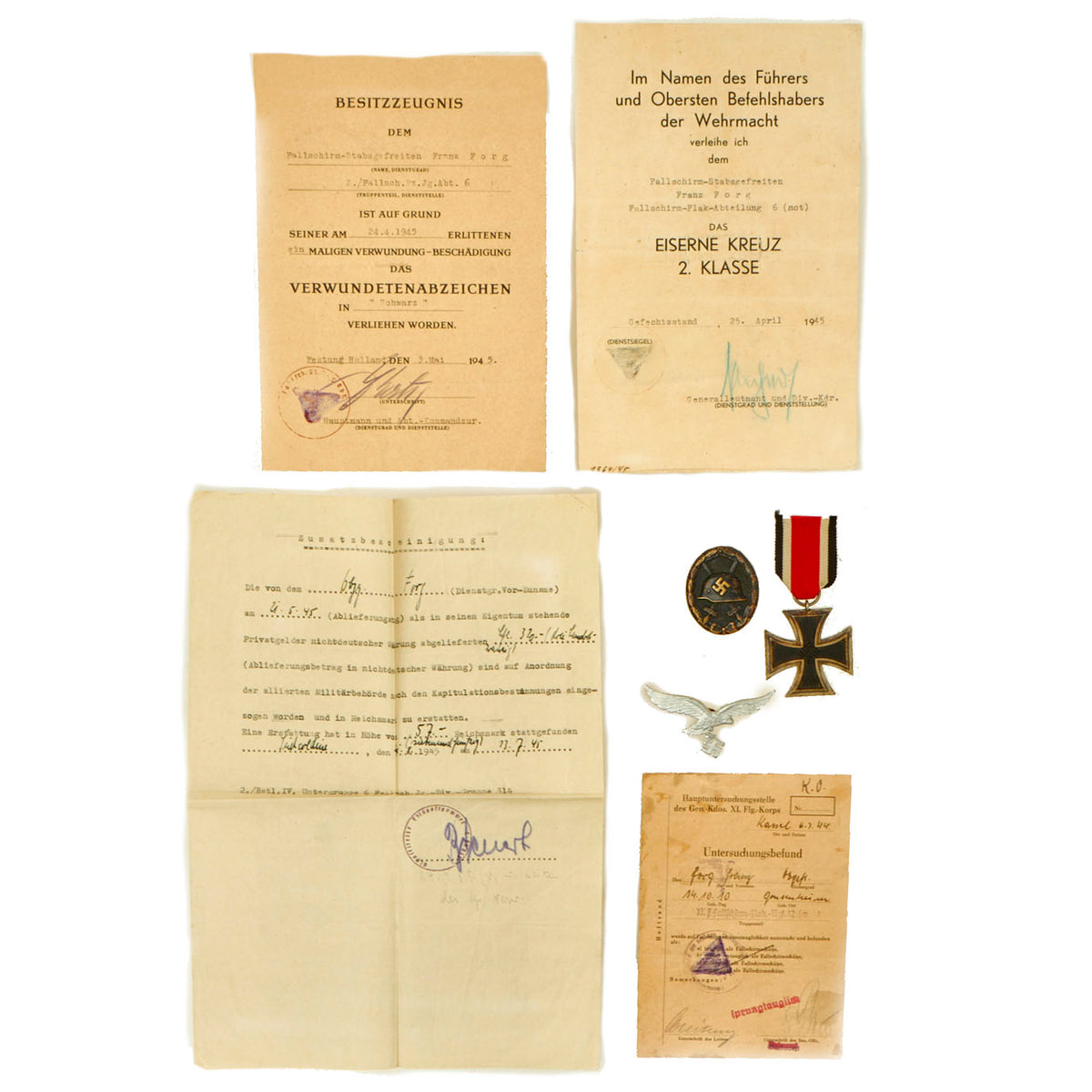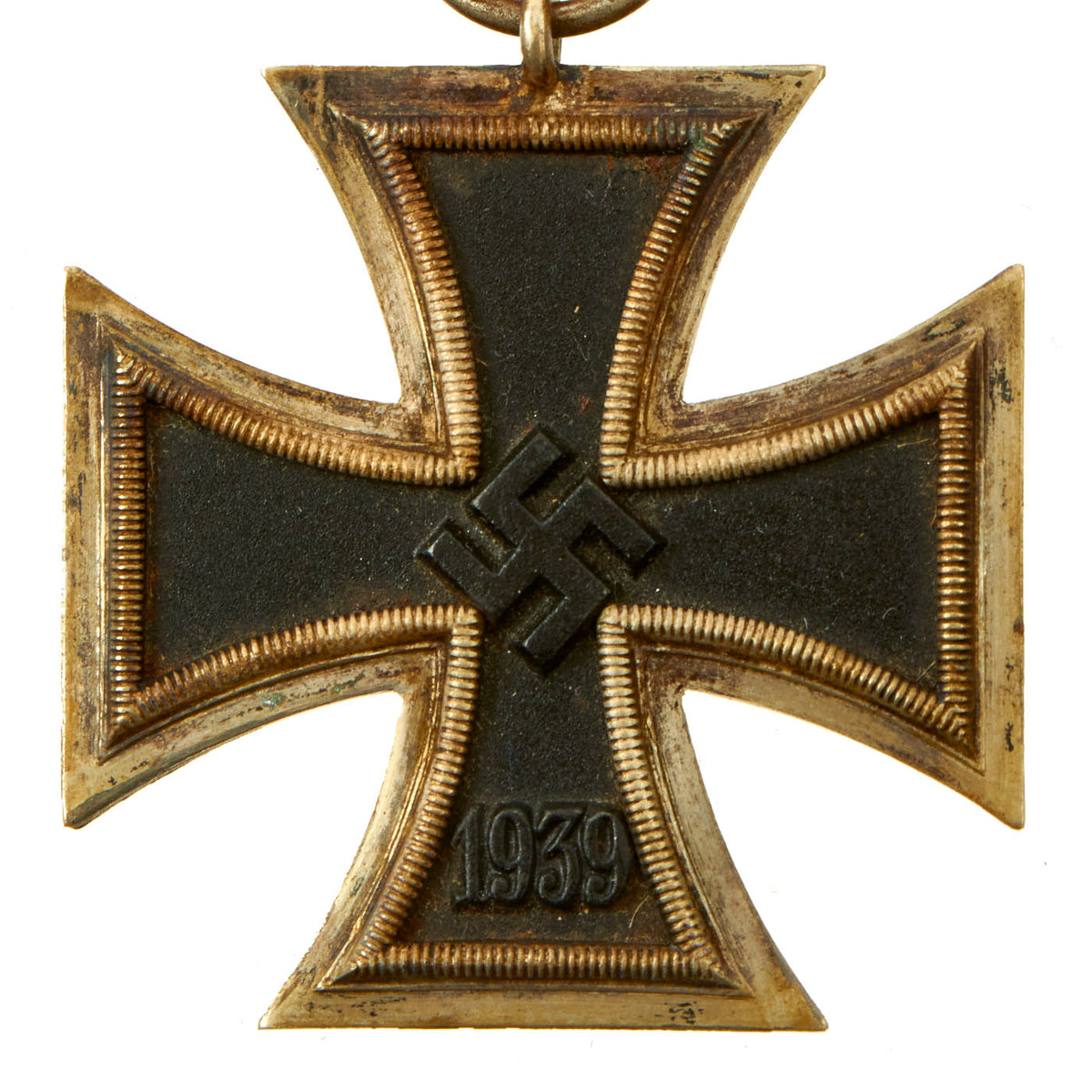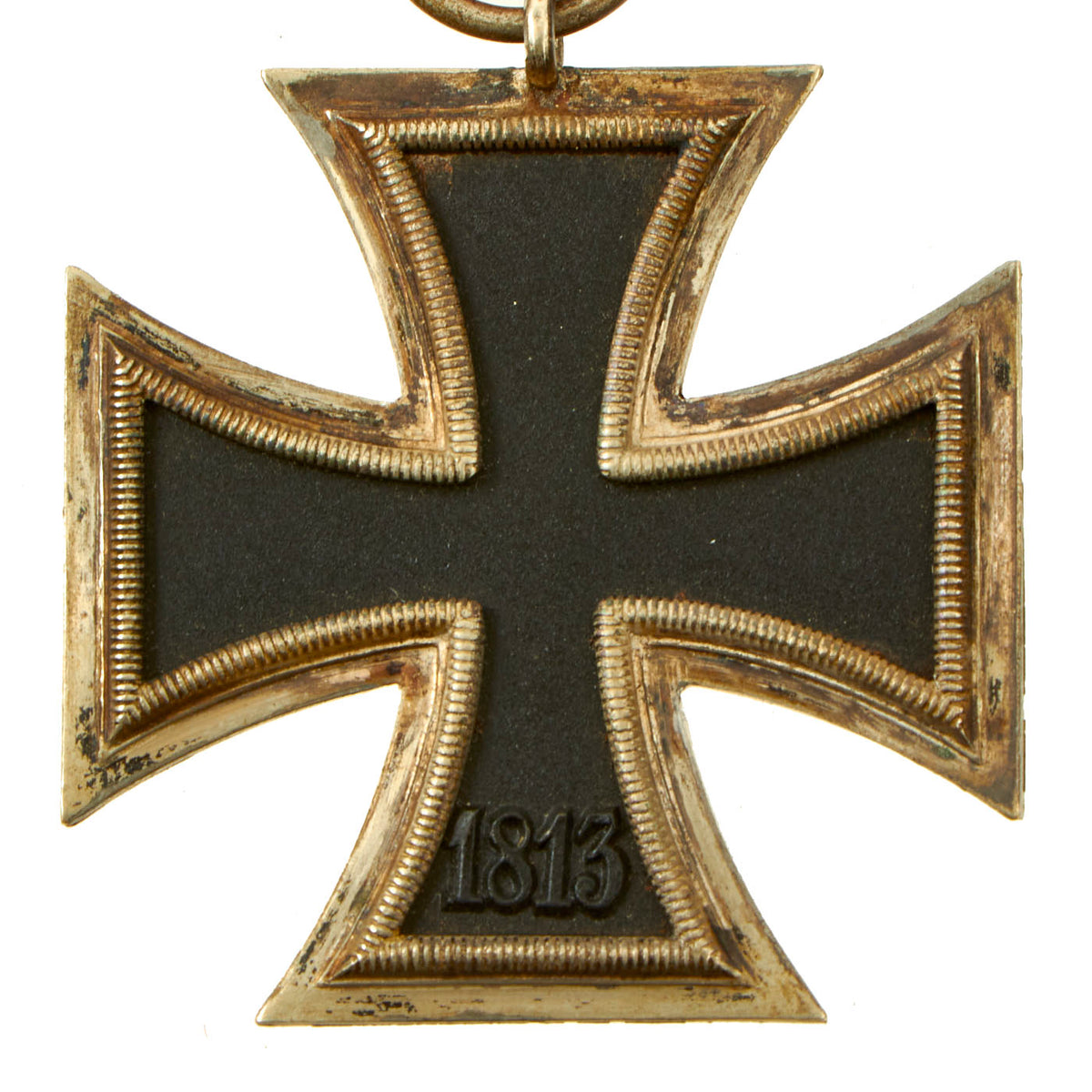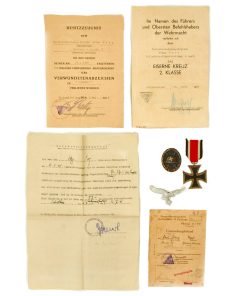Original German WWII Luftwaffe Award & Document Set named to Franz Forg of Paratrooper Flak Detachment 6 Original Items
$ 695,00 $ 208,50
Original Items: One-of-a-kind grouping. This is a fantastic named Luftwaffe Fallschirmjäger Paratrooper Flak Artillery set, with two original German WWII awards, each with their original BESITTZZEUGNIS “possession/award” certificates, as well as an aluminum visor cap eagle. There are also two additional documents as well, and all are named to the same soldier, Fallschirm-Stabsgefreiter Franz Forg, who in 1945 was a member of the Fallschirm-Flak-Abteilung 6 (mot). or the Paratrooper Flak Detachment 6 (motorized). This unit seems to have had several similar designations, as one of the award documents has Forg’s unit as 2. / Fallsch. Pz. Jg. Abt. 6, which without abbreviations is 2. / Fallschirm-Panzer-Jäger Abteilung 6. During the war units were routinely renamed, and this was particularly prominent during the closing days of WWII.
The first document in the set is named to Forg, Franz Obgefr., and is actually his Fallschirmschütze (Paratrooper) qualification from the XI. Flg.Korps. This certification was given in Kassel on 6. 7. 44., and has the signatures of the leader of the training as well as a medical officer. The second document indicates that Fallschirm-Stabsgefreiten Franz Forg was awarded the EISERNE KREUZ 2. KLASSE on 25. April 1945. This represents a slight promotion from the Obergefreiter rank. In the last years of World War II Stabsgefreiters were often used as group leaders Gruppenführer due to a lack of Unteroffiziere (NCOs).
It would appear that on 24. 4. 1945 Forg was wounded, which is right around the time that he was awarded the EKII, so it may have been related to that action. This earned him the VERWUNDETENABZEICHEN IN “Schwarz”. As often seen, it was awarded somewhat later on 3. Mai 1945., and the document gives his unit as the 2. / Fallsch. Pz. Jg. Abt. 6, though this is probably just due to the unit being renamed. The last document is dated 21. 5. 45 and is a request for supplemental pay. It is somewhat hard to read due to the handwriting.
The two included awards earned by Forg (in date order) are the Eisernes Kreuz II. Klasse 1939 (Iron Cross 2nd Class 1939 – EK II) and the Verwundetenabzeichen in Schwarz (Wound Badge in Black – 3rd Class). Both of the awards are in very good condition, with the EKII coming with its original ribbon. The wound badge has had the pin break off the back, but it is included. Both awards are unmarked, very common for late war issued awards.
The two award documents measure approximately 5 1/2″ x 8″, and are printed on mid-weight paper with black print and typed in particulars. The paratrooper qualification is a bit smaller, while the supplemental pay authorization is the larger 8″ x 11 1/2″ size and is on very light weight typewriter paper. All of the documents are dated, with their correct stamps and signatures. They are in good condition, with the expected wear and yellowing from age, and show folding. They have however all had the NSDAP insignia overwritten with marker to obscure the swas markings. Please consult the pictures for condition specifics.
A really nice German late WWII award & document set, named to a Luftwaffe Paratrooper flak soldier. A fantastic research opportunity, as well as a great display piece!
There is no more iconic German military award than the Iron Cross. The long history of this order began during the Napoleonic Wars. King Friedrich Wilhelm III of Prussia instituted the “Eisernes Kreuz” (Iron Cross) in March of 1813. The award criteria changed somewhat with time, but generally speaking, Iron Crosses could be awarded for individual acts of bravery, or for leadership achievements on the battlefield. The design was created by a Karl Friedrich Schinkel, his choice of the black cross with silver outline was derived from the heraldic emblem of the Teutonic Knights. This central Tatzenkreuz (cross pattée) struck from iron and mounted in a silver frame which has a raised crenulated decorative border.
The final reinstitution of the cross came in 1939. For this version, the front of the core for both grades bore a swas and the date 1939. The oak leaves, crown and royal initials were removed from the reverse, with only the date 1813 remaining as a reminder of the legacy of this award. In WWII, hundreds of thousands of Iron Cross First Class awards were bestowed, and four and a half million Iron Cross Second Class awards. Iron Crosses were made by a large number of authorized manufacturers. Some variants of these awards were mass produced in huge numbers. Others were made in very limited quantities. Please note the edge seam for authentication, which is not present on reproductions.
The Wound Badge (German: Verwundetenabzeichen) was a military decoration first promulgated by Wilhelm II, German Emperor on 3 March 1918, which was awarded to wounded or frostbitten soldiers of the Imperial German Army, during World War I. Between the world wars, it was awarded to members of the German armed forces who fought on the Nationalist side of the Spanish Civil War, 1938–39, and received combat related wounds. It was awarded to members in the Reichswehr, the Wehrmacht, SS and the auxiliary service organizations during the Second World War. After March 1943, due to the increasing number of Allied bombings, it was also awarded to wounded civilians in air raids. It was awarded when the wound was the result of enemy hostile action, with an exception being for frostbite.
The badge had three classes:
– Black (3rd class, representing Iron), for those wounded once or twice by hostile action (including air raids).
– Silver (2nd class) for being wounded three or four times.
– Gold (1st class, which could be awarded posthumously) for five or more times wounded.
The “progression” could be waived in the event of loss of a limb or eyesight; when such a severe wound occurred, the silver badge was awarded.
Fast Shipping with Professional Packaging
Thanks to our longstanding association with UPS FedEx DHL, and other major international carriers, we are able to provide a range of shipping options. Our warehouse staff is expertly trained and will wrap your products according to our exact and precise specifications. Prior to shipping, your goods will be thoroughly examined and securely secured. We ship to thousands clients each day across multiple countries. This shows how we're dedicated to be the largest retailer on the internet. Warehouses and distribution centres can be located throughout Europe as well as the USA.
Note: Orders with more than one item will be assigned a processing date depending on the item.
Before shipping before shipping, we'll conduct a thorough inspection of the items you have ordered. Today, the majority of orders will be delivered within 48 hours. The delivery time will be between 3-7 days.
Returns
The stock is dynamic and we cannot completely manage it because multiple stakeholders are involved, including our factory and warehouse. So the actual stock may alter at any time. It's possible that you may not receive your order once the order has been made.
Our policy is valid for a period of 30 days. If you don't receive the product within 30 days, we are not able to issue a refund or an exchange.
You can only return an item if it is unused and in the same state as the day you received it. You must have the item in its original packaging.
Related products
Uncategorized
Uncategorized
Australian WWII Owen MK1 Machine Carbine SMG Custom Fabricated Replica with Sling Original Items
Uncategorized
Angolan Rebel 1970s era 60mm Inert Display Mortar from Angolan Civil War Original Items
Uncategorized
Uncategorized
Uncategorized
Uncategorized
Uncategorized
Uncategorized
Uncategorized
Uncategorized
Uncategorized
Armored Burgonet Helmet & Polearm from Scottish Castle Leith Hall Circa 1700 Original Items
Uncategorized
Uncategorized
Uncategorized
Band of Brothers ORIGINAL GERMAN WWII Le. F.H. 18 10.5cm ARTILLERY PIECE Original Items
Uncategorized













































































